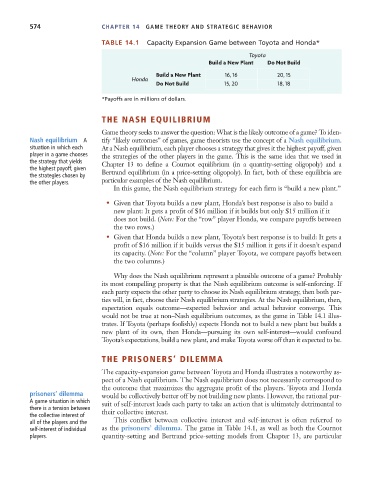Page 600 - Microeconomics, Fourth Edition
P. 600
c14gametheoryandstrategicbehavior.qxd 8/6/10 8:22 AM Page 574
574 CHAPTER 14 GAME THEORY AND STRATEGIC BEHAVIOR
TABLE 14.1 Capacity Expansion Game between Toyota and Honda*
Toyota
Build a New Plant Do Not Build
Build a New Plant 16, 16 20, 15
Honda
Do Not Build 15, 20 18, 18
*Payoffs are in millions of dollars.
THE NASH EQUILIBRIUM
Game theory seeks to answer the question: What is the likely outcome of a game? To iden-
Nash equilibrium A tify “likely outcomes” of games, game theorists use the concept of a Nash equilibrium.
situation in which each At a Nash equilibrium, each player chooses a strategy that gives it the highest payoff, given
player in a game chooses the strategies of the other players in the game. This is the same idea that we used in
the strategy that yields Chapter 13 to define a Cournot equilibrium (in a quantity-setting oligopoly) and a
the highest payoff, given Bertrand equilibrium (in a price-setting oligopoly). In fact, both of these equilibria are
the strategies chosen by
the other players. particular examples of the Nash equilibrium.
In this game, the Nash equilibrium strategy for each firm is “build a new plant.”
• Given that Toyota builds a new plant, Honda’s best response is also to build a
new plant: It gets a profit of $16 million if it builds but only $15 million if it
does not build. (Note: For the “row” player Honda, we compare payoffs between
the two rows.)
• Given that Honda builds a new plant, Toyota’s best response is to build: It gets a
profit of $16 million if it builds versus the $15 million it gets if it doesn’t expand
its capacity. (Note: For the “column” player Toyota, we compare payoffs between
the two columns.)
Why does the Nash equilibrium represent a plausible outcome of a game? Probably
its most compelling property is that the Nash equilibrium outcome is self-enforcing. If
each party expects the other party to choose its Nash equilibrium strategy, then both par-
ties will, in fact, choose their Nash equilibrium strategies. At the Nash equilibrium, then,
expectation equals outcome—expected behavior and actual behavior converge. This
would not be true at non–Nash equilibrium outcomes, as the game in Table 14.1 illus-
trates. If Toyota (perhaps foolishly) expects Honda not to build a new plant but builds a
new plant of its own, then Honda—pursuing its own self-interest—would confound
Toyota’s expectations, build a new plant, and make Toyota worse off than it expected to be.
THE PRISONERS’ DILEMMA
The capacity-expansion game between Toyota and Honda illustrates a noteworthy as-
pect of a Nash equilibrium. The Nash equilibrium does not necessarily correspond to
the outcome that maximizes the aggregate profit of the players. Toyota and Honda
prisoners’ dilemma would be collectively better off by not building new plants. However, the rational pur-
A game situation in which suit of self-interest leads each party to take an action that is ultimately detrimental to
there is a tension between their collective interest.
the collective interest of
all of the players and the This conflict between collective interest and self-interest is often referred to
self-interest of individual as the prisoners’ dilemma. The game in Table 14.1, as well as both the Cournot
players. quantity-setting and Bertrand price-setting models from Chapter 13, are particular

